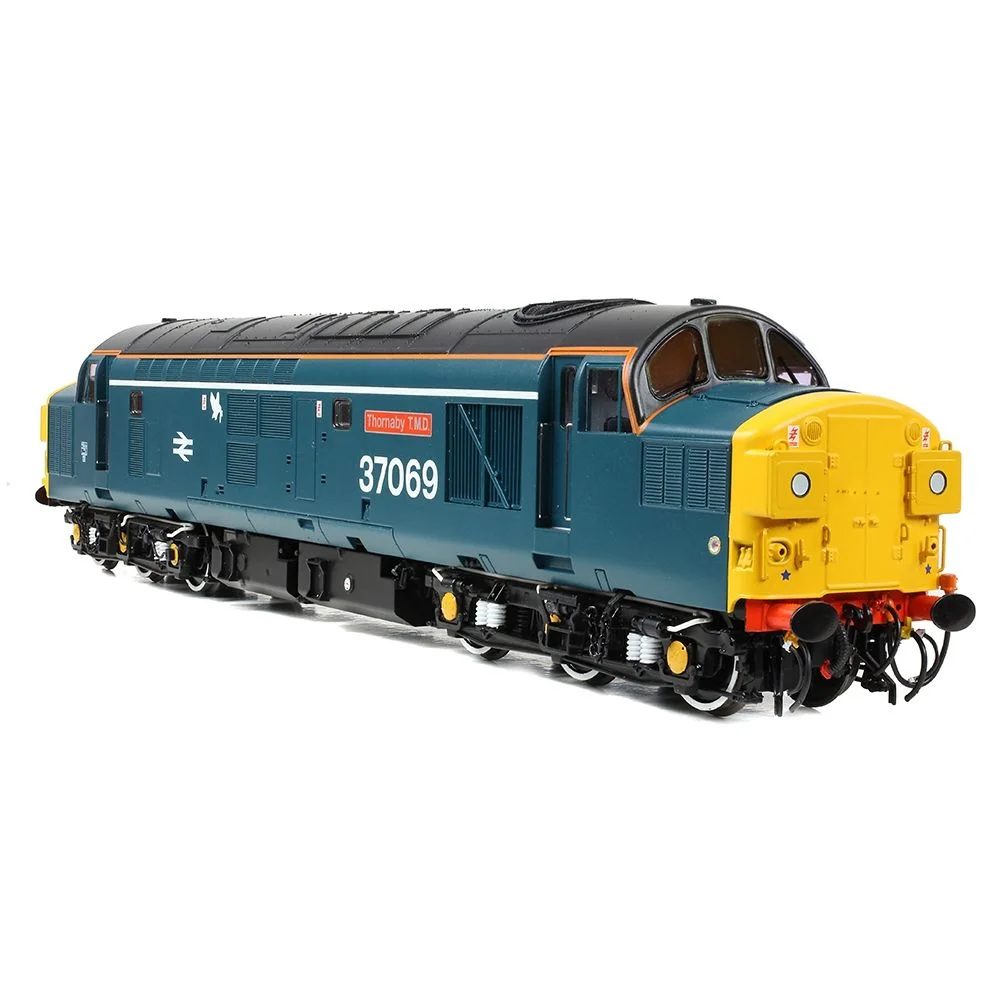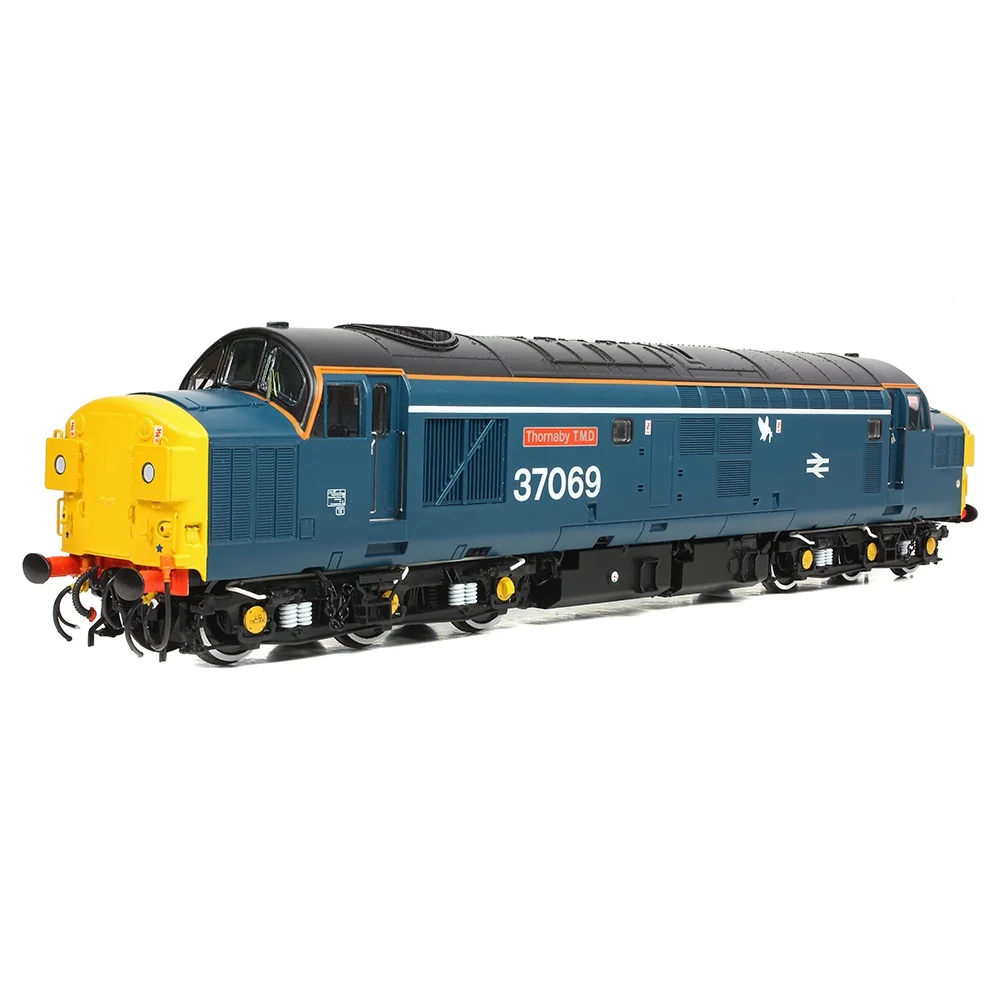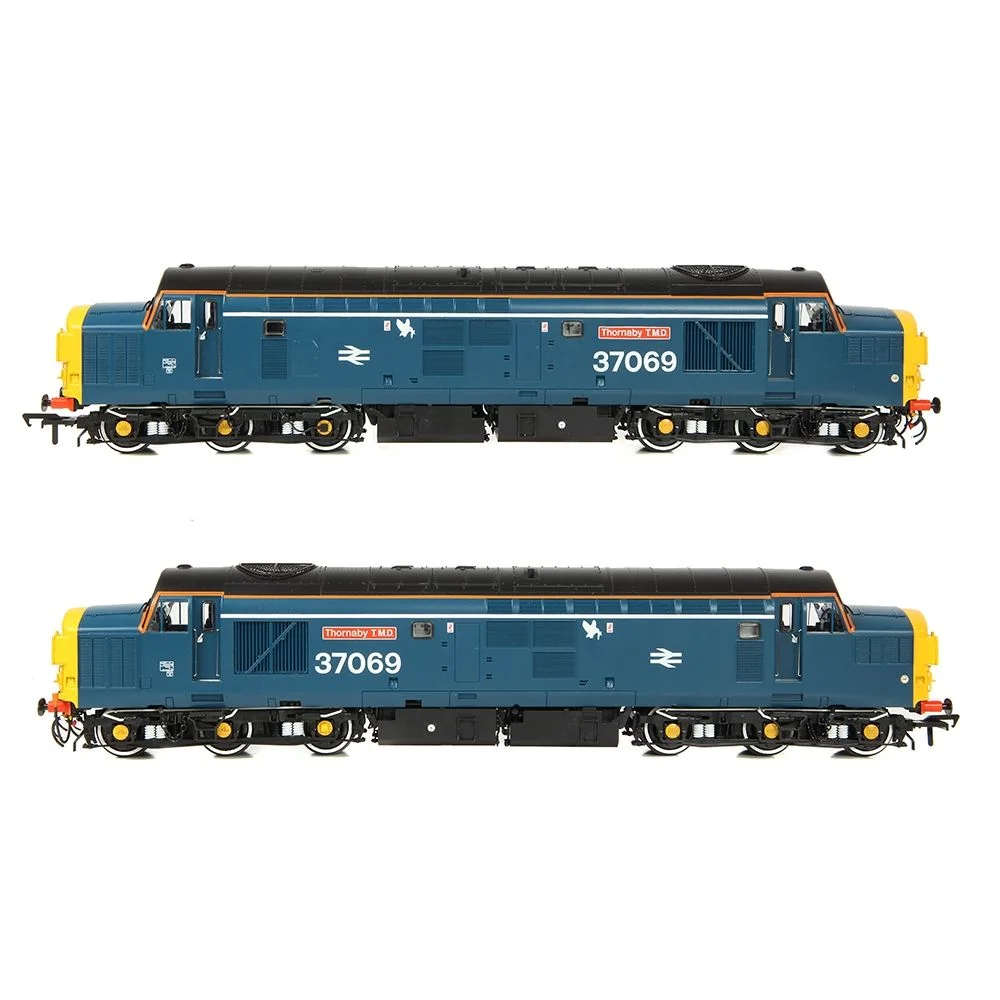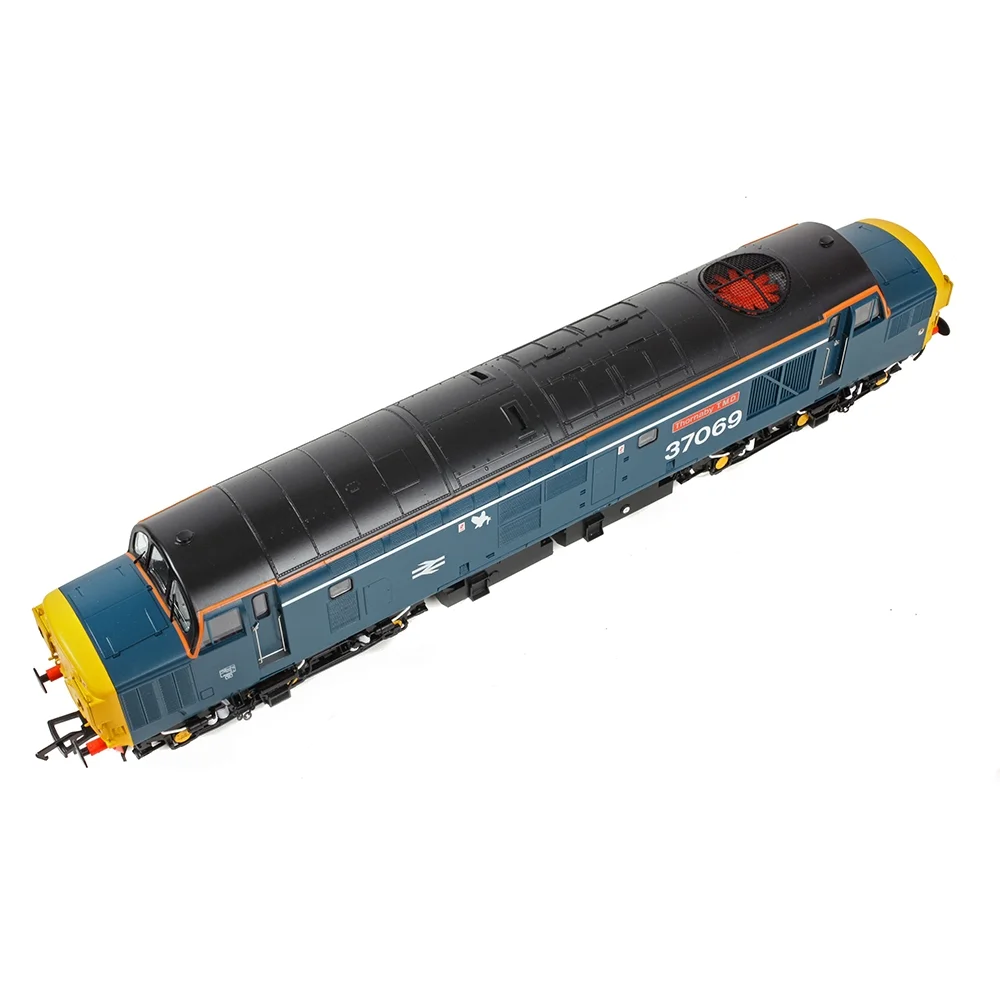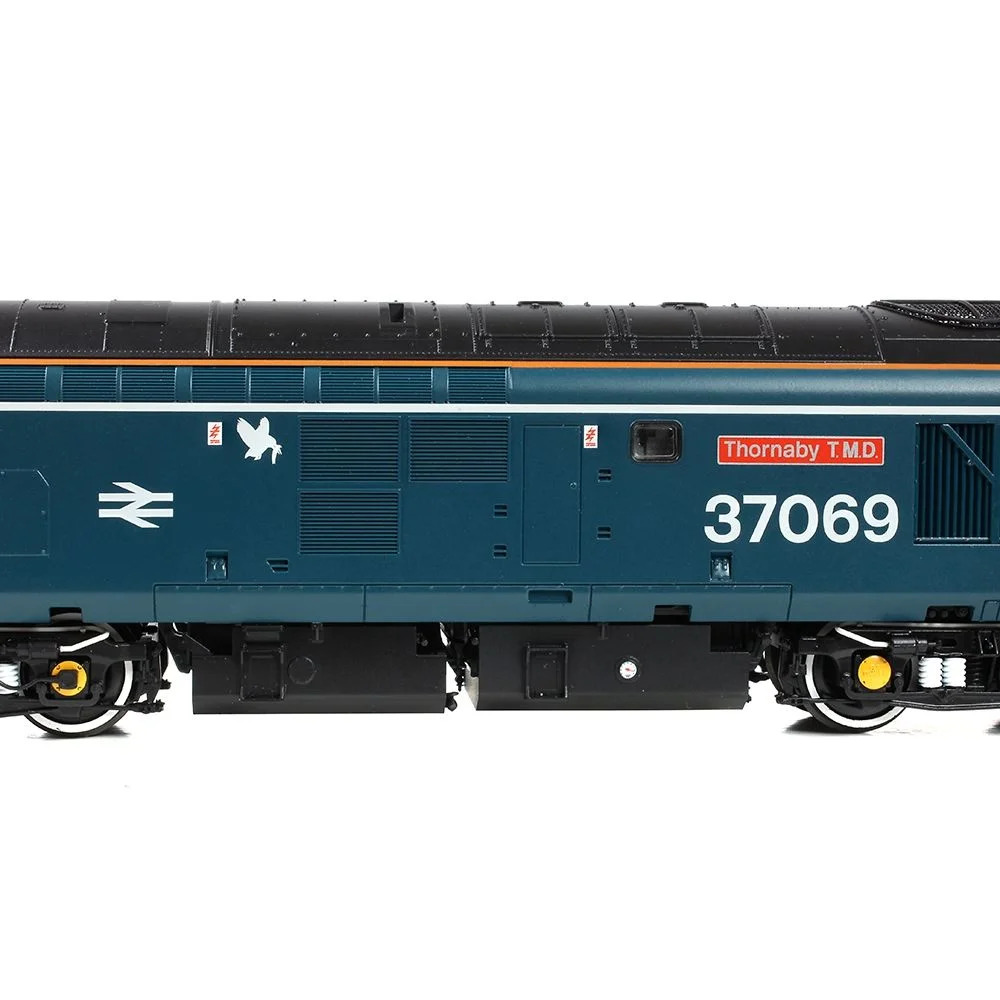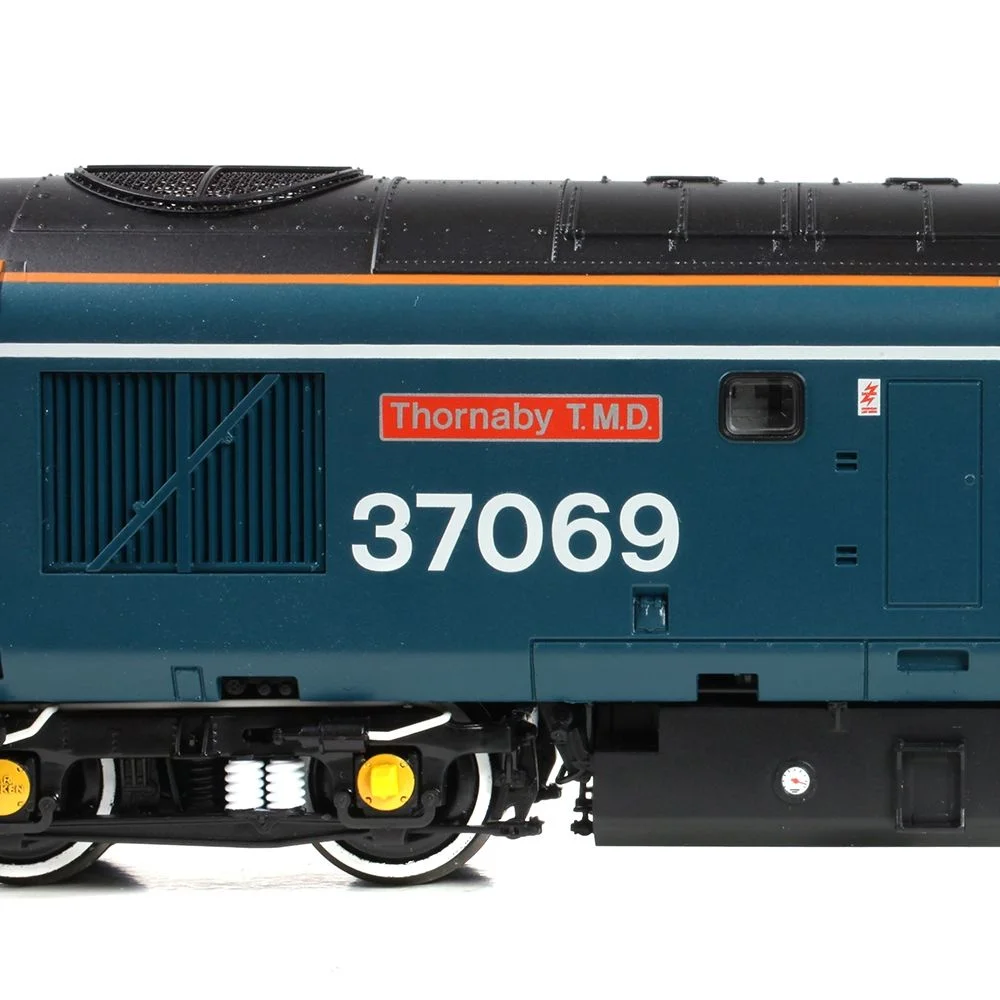Bachmann 35-312SF
British Rail Class 37/0 37069 "Thornaby TMD" British Rail Blue
Tooling
The British Rail Class 37, an English Electric Type 3 diesel locomotive, has long been a favourite among enthusiasts. In 2022, Bachmann Europe unveiled an all-new tooling for its OO gauge (1:76 scale) Branchline range, replacing previous versions and setting a new benchmark for fidelity and technology. This upgrade followed the success of the Class 47 retooling and was designed from the rails up using original drawings, site surveys, and extensive research.
Tooling Features
- Scale: OO gauge (1:76).
- Construction: High-fidelity plastic bodyshell with a diecast metal chassis for strength and weight.
- Detailing: Numerous separately fitted parts including handrails, lamp irons, jumper cables, etched fan grilles, NRN aerials, and bufferbeam detail packs. Sprung metal buffers are standard.
- Cab & Interior: Fully detailed and painted cab interiors with legible placards and optional crew figures.
- Couplings: NEM362 pockets with detachable tension-lock couplers.
- Variants: Extensive tooling suite covering Class 37/0 (split and centre headcode) and Class 37/4, with detail variations for boiler fittings, bogies, and headcode panels.
Mechanical & Electrical Specification
- Motor: Five-pole, twin-shaft motor with twin flywheels for smooth, powerful performance.
- Drive: All-axle drive with electrical pickup from all wheels; separate metal bearings for each axle.
- Chassis: Diecast metal block and bogie towers with diecast gearboxes for durability.
- Minimum Radius: Second radius curves (approx. 438mm).
- Lighting: Directional headlights and tail lights, cab and engine room lights on DCC. New “Yard Light” mode allows red tail lights at both ends.
- Weighting: Integrated diecast chassis for excellent adhesion and haulage.
DCC Capability
- DCC Ready with a Plux22 decoder socket.
- Factory SOUND FITTED versions use Zimo MS450P22 decoders with authentic sound projects.
- SOUND FITTED DELUXE models include a motorised radiator fan and tinted windscreen glazing.
- Dual Fitted speaker system pre-installed on all models for enhanced sound reproduction.
Liveries Produced
The new tooling has been released in a wide range of authentic liveries across multiple eras, including:
- BR Blue and BR Large Logo Blue
- Railfreight Red Stripe and Triple Grey
- Regional Railways
- Colas Rail Freight
- Direct Rail Services (DRS)
Reviews & Commentary
The 2022 upgrade has been widely praised for its accuracy, exceptional detailing, and technical sophistication. Reviewers highlight the exquisite livery application, lighting features, and smooth running qualities. SOUND FITTED DELUXE models, with their motorised fan and tinted glazing, have been described as “premium experiences.” However, some commentary notes the high price point compared to competitors such as Accurascale, sparking debate among enthusiasts.
Media & Social Media
Video reviews and social media discussions emphasize the model’s fidelity and performance. Popular YouTube reviews commend the finish, tampo printing, and sound quality, while noting that the model is aimed at the high-end market. Enthusiasts on forums have praised the rotating fan feature and cab detailing, though some question the necessity of a complete retool given the quality of previous versions.
Class & Prototype
- Class: British Rail Class 37/0
- Traction: Diesel
- Transmission: Electric
- Built: 1960-1965
- Total Built: -
The British Rail Class 37 is one of Britain's most successful diesel locomotive designs, with 309 locomotives built 1960-1965 by English Electric. Powered by the proven 12CSVT diesel engine producing 1,750 bhp, these Co-Co diesels served for 65 years on freight, passenger, and mixed-traffic duties across the entire BR network. Known as "Tractors" for their distinctive exhaust note, Class 37s worked everything from East Anglian expresses to West Highland Line services, Welsh coal trains, and nuclear flask operations. Extensive 1980s refurbishment created specialist subclasses including 37/4 ETH passenger variants, 37/5 freight, 37/7 heavy freight, and 37/6 Nightstar variants. Approximately 60 remain in mainline service with 30 preserved. Comprehensive OO gauge models available from Bachmann, Accurascale, and Hornby; N gauge from Graham Farish; O gauge from Heljan across extensive livery ranges spanning BR green through privatisation eras.
No prototype found.
Operator & Livery
- Operator: British Rail
- Livery: Blue
British Rail (1965-1997) transformed Britain's railways through revolutionary modernisation, introducing the iconic double arrow logo, Rail Blue livery, and business sectorisation. BR pioneered high-speed rail with the InterCity 125 and Advanced Passenger Train, electrified major routes, and created profitable divisions like InterCity and Network SouthEast. From steam succession through diesel and electric development to privatisation preparation, British Rail's diverse locomotive fleet, multiple livery schemes, and operational scenarios provide unparalleled variety for railway modellers across all scales and periods.
BR Blue, also known as Rail Blue or Monastral Blue, was introduced in 1965 as part of British Rail's comprehensive corporate identity overhaul that accompanied the rebranding from British Railways to British Rail. The colour was officially defined by British Standards BR28/6001 (airless spray finish) and BR28/5321 (brush finish), representing a dark, greyish blue tone specifically chosen to hide dirt and weathering effects well.
The livery was prototyped on the experimental XP64 train in 1964 before becoming the standard scheme from 1 January 1965. Rail Blue was applied to all diesel and electric locomotives with yellow warning panels (initially small, then extending to full yellow ends from 1966). The standardised application included the iconic double arrow logo and Rail Alphabet typeface, creating one of the most successful transport corporate identities of the 20th century.
The livery dominated British Rail operations for over two decades until sectorisation in the 1980s began fragmenting the unified appearance. Despite initial colour fading problems in early applications, these were resolved by the late 1970s when the Large Logo variant was introduced featuring extended yellow areas and full-height double arrow symbols. Rail Blue's enduring appeal among railway enthusiasts reflects its role as the definitive British Rail image during the organisation's most unified period.
